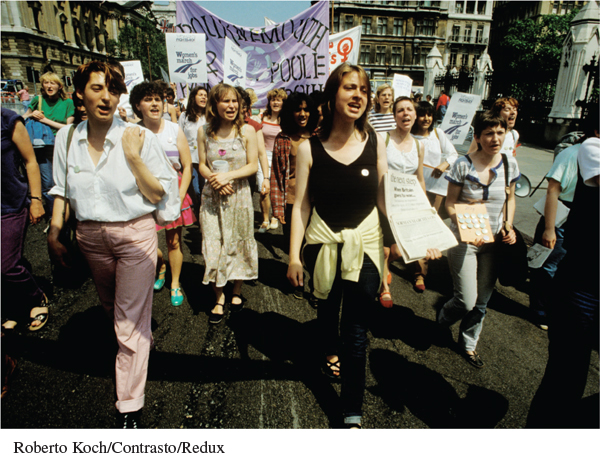A History of Western Society: Printed Page 997
A History of Western Society, Value Edition: Printed Page 958
A History of Western Society, Concise Edition: Printed Page 1000
Challenges and Victories for Women
The 1970s marked the arrival of a diverse and widespread feminist movement devoted to securing genuine gender equality and promoting the general interests of women. Three basic reasons accounted for this dramatic development. First, ongoing changes in underlying patterns of motherhood and paid work created novel conditions and new demands (see Chapter 28). Second, a vanguard of feminist intellectuals articulated a powerful critique of gender relations, which stimulated many women to rethink their assumptions and challenge the status quo. Third, taking a lesson from the civil rights movement in the United States and protests against the Vietnam War, dissatisfied women recognized that they had to band together if they were to influence politics and secure fundamental reforms.
Feminists could draw on a long heritage of protest, stretching back to the French Revolution and the women’s movements of the late nineteenth century (see Chapters 19 and 22). They were also inspired by recent writings, such as the foundational book The Second Sex (1949) by the French writer and philosopher Simone de Beauvoir (1908–1986). Beauvoir, who worked closely with the existentialist philosopher Jean-
The Second Sex inspired a generation of women intellectuals, and by the late 1960s and the 1970s “second-
Many other women’s organizations rose in Europe and North America. The diverse groups drew inspiration from Marx, Freud, or political liberalism, but in general feminists attacked patriarchy (the domination of society by men) and sexism (the inequalities faced by women simply because they were female). Throughout the 1970s a proliferation of publications, conferences, and institutions devoted to women’s issues reinforced the emerging international movement. Advocates of women’s rights pushed for new statutes governing the workplace: laws against discrimination, acts requiring equal pay for equal work, and measures such as maternal leave and affordable day care designed to help women combine careers and family responsibilities.

The movement also addressed gender and family questions, including the right to divorce (in some Catholic countries), legalized abortion, the needs of single mothers, and protection from rape and physical violence. In almost every country, the effort to decriminalize abortion served as a catalyst in mobilizing an effective, self-
In countries that had long placed women in a subordinate position, the legal changes were little less than revolutionary. In Italy, for example, new laws abolished restrictions on divorce and abortion that had been strengthened by Mussolini and defended energetically by the Catholic Church in the postwar era. By 1988 divorce and abortion were common in Italy, which had the lowest birthrate in Europe. While the women’s movement of the 1970s won new rights for women, subsequently it became more diffuse, a victim of both its successes and the resurgence of an antifeminist opposition.